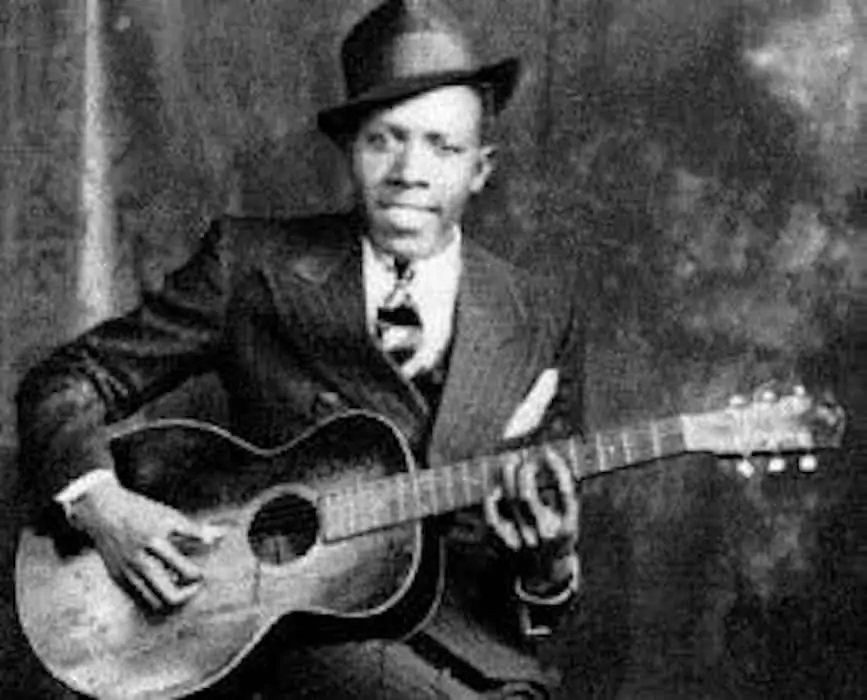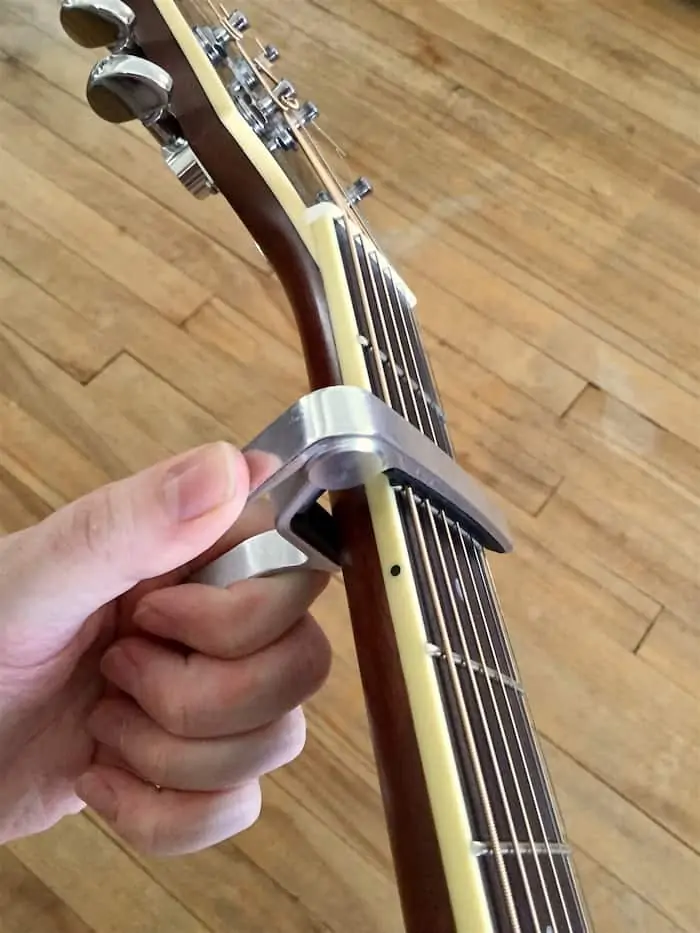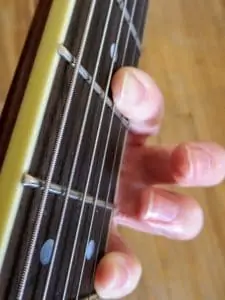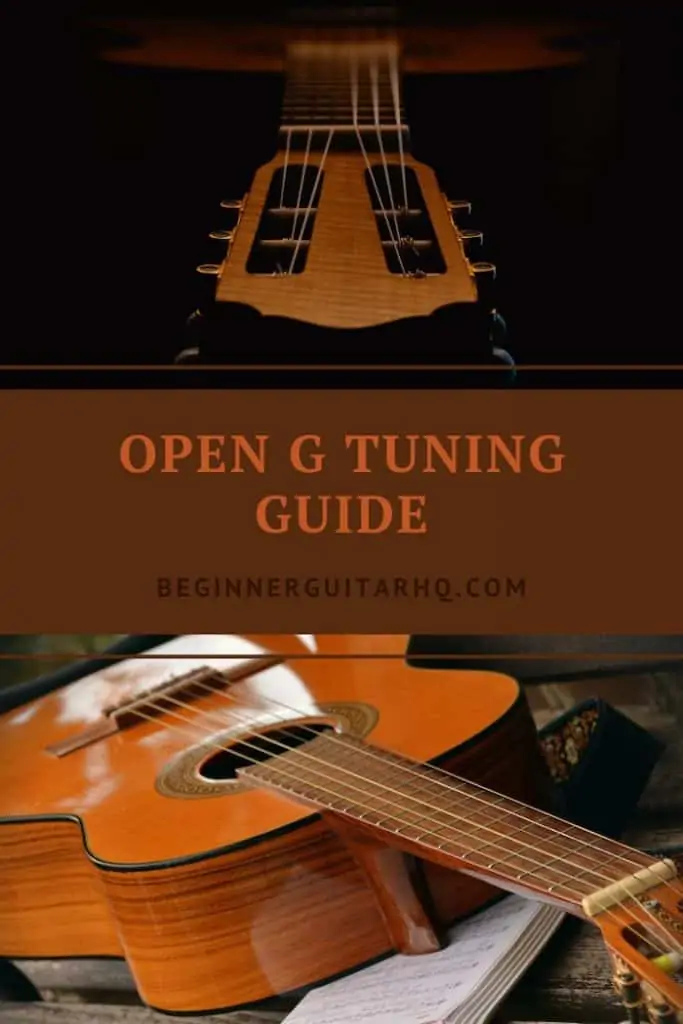You’ve been playing guitar for a while now. You know your basic chords and scales. You’ve even memorized a few songs to whip out at parties. But now you’re looking for a new challenge. In this case, it might be time to unlock some alternate tunings.
Most popular guitar songs are written in standard tuning. From the 6th string to the 1st string, your strings should be tuned to these notes –– E A D G B E.
The good thing about standard tuning is that you can play songs in any major or minor key. But the downside is that you have to memorize dozens of chord shapes across the fretboard. Some of these also involve a giant stretch across 3, 4 or even 5 frets! Not ideal, especially if you have small hands.
This is where open tunings come to the rescue. These types of alternate tuning produce either a major or a minor chord when you strum all 6 strings at once. To fret your other major or minor chords, all you need to do is barre your index finger across the strings. Piece of cake!
Aside from Open D, Open G is the most popular of these tunings. Its unique sonic possibilities make it a favorite with slide players especially. You can also find it in fingerpicking and strumming styles like blues rock, alternative, folk and Hawaiian Slack Key (where it’s usually called “Taro Patch” tuning).
Delta blues legend Robert Johnson was a big fan of Open G tuning. It also features in many songs by The Rolling Stones, Led Zeppelin, George Thorogood and the Destroyers, Joni Mitchell and The Black Crowes.
This guide will help you learn essential chords and scales in Open G tuning. We’ll also look at some popular Open G songs you can add to your setlist.
Contents
Tuning Basics
Let’s start by looking at the most common form of Open G tuning –– D G D G B D.
Here’s a breakdown of the changes from standard tuning:
- 6th string: downtuned one whole tone
- 5th string: downtuned one whole tone
- 4th string: stays the same
- 3rd string: stays the same
- 2nd string: stays the same
- 1st string: downtuned one whole tone
D G D G B D aren’t the only string options. Joni Mitchell often uses a G G D G B D variation, tuning the 6th string up three half tones to place the root note in the bass string. Rolling Stones guitarist Keith Richards has a 5-string guitar that omits the 6th string entirely, placing G as the bass note. Meanwhile, resonator guitars (also called dobros) often use a G B D G B D tuning, especially in bluegrass music.
Like resonators, 7-string Russian guitars are traditionally tuned to Open G, with an added D bass note –– D G B D G B D.
For easier minor chord voicings, some guitarists modify Open G to Em7 (or G/E), with the notes E G B D G B. But for now, we’ll keep it simple by sticking to D G D G B D.
On a final note, you can use any of these variations to access other open tunings, like A (capo on the 2nd fret), B♭ (capo on the 3rd fret) and so on.
Add a capo to the 2nd fret to access Open A tuning –– E A E A C♯ E.
Whenever you change out of standard tuning, it may take some time for your guitar to adjust to the new tension on the neck. Don’t worry though. You’ll just need to re-tune a bit more often for a day or so.
Many players who use alternate tunings prefer to buy medium gauge strings (also called 11s, for electric guitar). They’re harder to fret than your standard lights. But they also cut down on the fret buzz that comes with downtuning (and therefore loosening) your strings.
Still struggling with fret buzz? You may also want to adjust your guitar’s action (the distance between your fretboard and strings). A higher action means you can press harder on your strings and still maintain a clear, strong sound.
Once you’ve tuned up and adjusted your strings/action, let’s move on to the basic chord shapes you’ll need to know…
Common Chords
If you’ve only played in standard tuning, learning new chord shapes in Open G may seem intimidating. But don’t sweat it! You can fret almost any chord triad as a moveable shape with a 5th-string or 3rd-string root note. You can also learn some open voicings for easy chord changes at the 1st-4th frets.
Moveable chords
First things first, you’ll need to memorize the notes on your new low G (5th) string. This is easy if you’ve already memorized the notes on your mid G (3rd) string in standard tuning. Or, you can think of the notes in your standard A string, then shift everything up by two frets.
Let’s say you want to play a C major chord. In standard tuning, you would slide up to the 3rd fret of your 5th string, adding your index barre and an A chord shape beneath. In Open G, you would slide up to the 5th fret instead, barring across the 5th-1st strings. Easy!
Because the lowest note is a D, most guitarists mute the 6th string when they play. Otherwise, your moveable barre chords would all be in 1st inversion, with the 5th note of each chord as the bass note, followed by the root and the 3rd. For example, when you play all 6 open strings, you technically get a G/D. This chord has a note order of D-G-B order instead of the standard G-B-D.
There’s nothing wrong with playing chords in 1st inversion. However, they sound a bit muddier and more ambiguous than root position chords. So for ultimate clarity, mute the 6th string with the tip of your finger whenever you fret a 5th-string root chord.
When you play a moveable major chord in Open G, you’re actually playing a single 3rd note, plus two root and 5th notes at different octaves (pitches). For example, from the 5th to the 1st string, the C major chord (C-E-G) includes the notes C-G-C-E-G. But for a focused, treble-heavy sound, you can play around with major triads by using only the 3rd-1st strings.
The three types of triads are:
- Root position: root note on the 3rd string, 3rd note on the 2nd string, 5th note on the 1st string (ex: C-E-G). All of these notes are played on the same fret.
- 1st inversion: 5th note on the 3rd string, root note one fret higher on the 2nd string, 3rd note two frets higher on the 1st string (ex: G-C-E).
- 2nd inversion: 3rd note on the 3rd string, 5th note one fret lower on the 2nd string, root note one fret higher on the 1st string (ex: E-G-C).
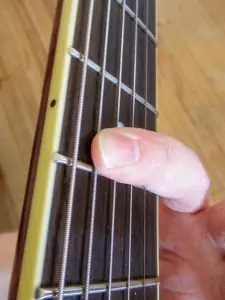

Moveable majors as full chords (top left), root position triads (top right), 1st-inversion triads (bottom left) and 2nd-inversion triads (bottom right).
Minor chords are slightly trickier than major chords, thanks to the ♭3rd note. For a 5th-string root, you’ll need to barre (or individually fret) the 5th-3rd strings and shift your index back one fret on the 2nd string. If your fingers are flexible enough, you can add your little finger to the 1st string. Or, you can mute it instead.
Here are the adjustments to turn your major triads into minor triads:
- Root position: slide one fret lower on the 2nd string (ex: C E♭G).
- 1st inversion: one fret lower on the 1st string (ex: G C E♭).
- 2nd inversion: one fret lower on the 3rd string (ex: E♭G C).


Moveable minors as full chords (top left), root position triads (top right), 1st-inversion triads (bottom left) and 2nd-inversion triads (bottom right).
You can also incorporate open strings into your moveable majors and minors for interesting extended chords. For example, you can turn your C major chord into a Cadd9 by releasing your fingers from the 3rd and 1st strings. If you slide this shape down to the 3rd fret, you get a B♭6. If you slide it up to the 7th fret, you get a Dadd11. And so on.
For minor versions of these chords, move your finger back one fret on the 2nd string.

These moveable extended major (left) and minor (right) chord shapes can jazz up any standard triad by adding extra notes from the parent scale.
Some other common moveable chords are:
- 7ths (or dominant 7ths): barre across the 5th-1st strings. Add your little finger three frets higher on the 1st string. Or, add your middle finger to the 5th string, ring finger to the same fret on the 4th string, little finger to the same fret on the 2nd string and index finger two frets lower on the 3rd string.
- Major 7ths: add your middle finger to the 5th string, ring finger to the same fret on 4th string, little finger to the same fret on the 2nd string and index finger one fret lower on the 3rd string.
- Power chords (or 5 chords): barre across the 5th-3rd or 3rd-1st strings. Note: you can also play your regular 4th-string (D) root power chords from standard tuning, as the 4th-2nd strings stay the same.
- Diminished chords: add your ring finger to the 5th string. Slide your index one fret lower on the 4th string and your middle finger one fret lower on the 2nd string. For a diminished 7th (the most common diminished voicing), add your little finger to the 3rd string on the same fret as your ring finger.
- Sus4s: barre across the 5th-1st strings. Add your middle finger one fret higher on the 2nd string.
- Sus2s: barre across the 5th-1st strings. Add your ring finger two frets higher on the 3rd string and little finger three frets higher on the 2nd string.
- Add9s: barre across the 5th-1st strings. Add your ring finger two frets higher on the 3rd string.
- 6ths: barre across the 5th-1st strings. Add your ring finger two frets higher on the 1st string.

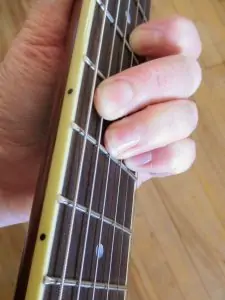



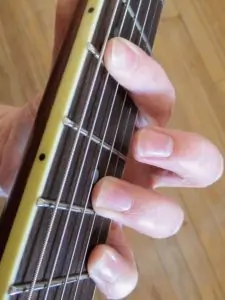

From top left to bottom left: moveable 7th – option 1, 7th – option 2, maj7th, 5th-string root power chord, 4th-string root power chord, diminished 7th, sus4, sus2, add9 and 6th voicings.
Open chords
In Open G tuning, most guitarists like to stick to moveable chord shapes. They’re easy to memorize and –– with a few exceptions –– easy to fret. But open position chords can also add variety to a progression.
It would take forever to list all of the chords you can play in Open G. So instead, we’ll look at the ones you’re most likely to come across.
Most G-root chords can be played the same way as the moveable shapes, treating the nut is the barre and adding the proper voicing below it. But there are some exceptions…
- Gm: 3rd fret of the 2nd and 3rd strings. Rest open (RO).
- Gmaj7: 4th fret of the 3rd and 4th strings. RO.
- G5: 3rd fret of 2nd string. RO.
- Gdim: open 5th string, 3rd fret of 3rd string and 2nd fret of 2nd string. Rest muted.
You can also play an open G major by adding a finger to the 5th fret of the 1st string. This gives you a pleasant, treble-heavy tone.
Other popular Open G chords include:
- A7: 2nd fret of the 3rd-1st strings.
- A7sus4: 5th fret of the 2nd string. Muted 1st string. RO.
- Am7: 2nd fret of the 5th and 3rd strings, 1st fret of the 2nd string. RO.
- Bm: 4th fret of the 5th-3rd strings. RO.
- C: 2nd fret of the 4th and 1st strings, open 3rd string, 1st fret of the 2nd string.
- Cadd9: like C, with an open 1st string.
- D: open 4th string, 2nd fret of the 3rd string, 3rd fret of the 2nd string, 4th fret of the 1st string.
- Dm/F: 3rd fret of the 4th and 2nd strings, 2nd fret of the 3rd string, open 1st string.
- D7: 2nd fret of the 3rd string, 1st fret of the 2nd string. RO (including 6th string).
- E: 2nd fret of the 4th and 1st strings, 1st fret of the 3rd string, open 2nd string.
- Em: 2nd fret of the 4th and 1st strings, open 3rd and 2nd strings.
- Em7: 2nd fret of the 6th and 4th strings. RO.
- F: 3rd fret of the 4th and 1st strings, 2nd fret of the 3rd string, 1st fret of the 2nd string.
Common Scales
Just like in standard tuning, you can play Open G major and minor scales (and their variations) at different positions around the fretboard.
The most basic scale is G major –– G A B C D E F♯ G. You can either start with the root note on the 5th string or add a 5-6-7 (D E F♯) note walkup from the 6th string.
The G major scale in Open G, ascending.
For an upbeat pop, rock or country solo, you might want to use the G major pentatonic scale instead. These five-note scales remove the tense 4th and 7th scale degrees from the major scale for a streamlined sound. Blues and jazz guitarists also add a dissonant ♭3rd note to the major pentatonic to create the major blues scale.
The G major pentatonic scale, ascending. For the G major blues scale, add the 3rd fret of the 6th and 4th strings.
To improv over a G natural minor scale, you’ll need to flat the 3rd, 6th and 7th scale degrees from G major. Minor pentatonics (aka the quintessential rock scales) skip the 2 and ♭6, while minor blues scales also add the ♭5 note.
The G minor blues scale, ascending. For the G minor pentatonic, skip the 6th fret of the 5th string and the 2nd fret of the 2nd string.
Using your 5th string as a guide, you can slide these patterns up the neck to play any scale. For example, you could start at the 2nd fret for an A-root scale, the 5th fret for a C-root scale, and so on.
Another cool thing about Open G is that you can easily play a D major scale, starting on the 6th string. It uses all the same notes as G major, but raises the C to a C♯.
The D major scale, ascending. Except for the note changes on the 6th fret of the 5th string and 2nd fret of the 2nd string, it is remarkably similar to a G major scale.
Again, you can use your 6th string as a guide to shift this D major pattern up the neck and play other scales.
Practice Songs
Now that we’ve got the essential chords and scales out of the way, here comes the fun part –– learning songs.
I find that the best way to get started is to work out some easy 3- or 4-chord songs with moveable Open G voicings. To make things even easier, let’s start with a few songs in the key of G major…
- “I Gotta Feeling” by Black Eyed Peas: G C Em C
- “Sweet Home Alabama” by Lynryd Skynyrd: D C(add9) G
- “Heart of Gold” by Neil Young: Em C D G x 3 for the verse, Em G C G for the chorus
Once you’re comfortable locating these basic chord voicings, you’re ready to tackle some proper Open G jams, like:
- “Daughter” by Pearl Jam
- “Start Me Up” by The Rolling Stones
- “I Can’t Be Satisfied” by Muddy Waters
This lesson covers the iconic slide guitar parts from Muddy Waters’ “I Can’t Be Satisfied”.
“Start Me Up” and “I Can’t Be Satisfied” can be played in your regular D G D G B D tuning. However, Pearl Jam guitarist Mike McCready uses Joni Mitchell-style G G D G B D tuning on “Daughter”. Technically, you can just mute the 6th string and stick with the normal Open G tuning. But it sounds a lot more authentic with a G note in the bass.
For a super easy Open G riff, check out this lesson for “Daughter” by Pearl Jam.
Some other well-known Open G songs are:
- “Watch Over You” by Alter Bridge
- “Walkin’ Blues” by Robert Johnson
- “Ain’t No Rest for the Wicked” by Cage The Elephant
- “Twice As Hard” by The Black Crowes
- “Spanish Fandango” by Chet Atkins
- “In My Time of Dying” by Led Zeppelin (capo on the 2nd fret)
- “Romeo and Juliet” by Dire Straits (capo on the 3rd fret)
- “Little Green” by Joni Mitchell (capo on the 4th fret)
“Walkin’ Blues”, “Ain’t No Rest for the Wicked”, “Twice As Hard” and “In My Time of Dying” are solid practice options for slide guitar. The others use fingerstyle patterns.
Final Thoughts
As a beginner, it’s tempting not to venture too far beyond standard tuning. But trust me –– it’s worth it to learn some basic chords, scales and songs in Open G.
Personally, I never tuned my guitar to anything beyond Drop D or Hendrix tuning (E♭ A♭ D♭ G♭ B♭ E♭) until I had been playing for almost 10 years. But I wish I had been more adventurous. For one thing, it would have made learning slide a lot easier. I also wouldn’t have wasted so much time trying to transcribe songs like George Thorogood’s “Bad to the Bone” from Open G into standard tuning.
Even if you’re not interested in essential Open G genres like blues slide, Hawaiian slack key or Russian folk music, it’s still an incredibly versatile tuning for Western rock and folk subgenres. Plus, once you’ve mastered Open G, you’ll find it easier to get started with other open tunings, like D, C and DADGAD (which is basically a Dsus4).
Who knows? Open G might just become your new favorite.

